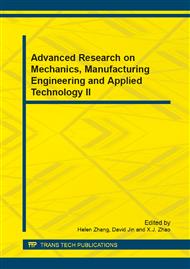p.56
p.60
p.64
p.68
p.72
p.79
p.83
p.88
p.92
The Research on Three-Dimensional Theoretical Model of Residual Stress on Cutting Surface
Abstract:
Two kinds of three-dimensional model of residual stress were discussed based on the three dimensional distribution characteristics of residual stress on machined surface, considering comprehensively the strain along the X, Y, Z three directions, to improve the two dimensional model of residual stress established by DL McDowell without considering the Z direction of the strain. As to the characteristics of milling force, strains of any point in the substrate surface along three directions can be calculated based on the elastic-plastic mechanics theory. With the improved models, both the distribution of residual stress on milled surface and the distribution of residual stress in subsurface layer can be obtained. By means of the examples of numerical calculation, the analytical result and simulation result are analyzed and compared. The improved model accorded better with the actual residual stress distribution on milled surface than original model.
Info:
Periodical:
Pages:
72-75
Citation:
Online since:
April 2014
Authors:
Price:
Сopyright:
© 2014 Trans Tech Publications Ltd. All Rights Reserved
Share:
Citation:


